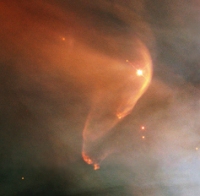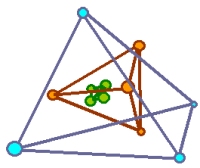Cross-Scale Technology Reference Study
Scientific Interest
 |
|
The interaction of the solar wind with Earth's magnetosphere shapes the near-Earth space plasma environment. (ESA) |
Plasma processes play a significant role in many astrophysical objects (e.g. in accretion disks, supernovae, and galactic disks) as well as in solar and solar-terrestrial physics. Near-Earth space, where the Earth's magnetosphere interacts with the solar wind, is an accessible natural laboratory for studying these complex dynamical space plasma processes.
The three universally dominating fundamental space plasma processes are:
- Shocks
- Reconnection
- Turbulence
All three phenomena involve time-varying nonlinear multi-scale interactions which generate complex plasma structures. Three typical length scales can be discerned (the quoted typical distances correspond to near-Earth space):
- Electron kinetic scale (~10 km),
- Ion kinetic scale (~100 - 1000 km)
- Magneto-hydrodynamic fluid or macro-scale (~5000 - 10 000 km)
 |
|
A bow shock near a young star. Image credit: NASA and the Hubble Heritage Team (STScI/AURA) |
Cross-Scale is mentioned in the ESA Cosmic Vision brochure (ESA BR-247) as Earth Magnetospheric Swarm, a candidate mission concept for the examination of plasma processes through the full hierarchy of scales, as part of a possible implementation strategy for answering the thematic question: 'How does the Solar System Work?'
Study Approach
The aim of the Cross-Scale Technology Reference Study is to establish a technically feasible mission profile for a multi-spacecraft multi-scale exploration of space plasmas. The optimal mission architecture will be derived through an extensive mission design trade. Next, a detailed consolidated system design will be carried out and a technology development and demonstration plan will be prepared.
Mission Concept Trade
 |
The preliminary mission concept for Cross-Scale consists of a constellation of plasma-instrumented spacecraft in a highly elliptical orbit around Earth. A near equatorial orbit has tentatively been selected for a detailed investigation of the following regions:
- Bow shock
- Magnetosheath
- Magnetotail/current sheet
 |
|
Optimum scientific configuration of the Cross-Scale constellation |
Known Mission Drivers
There are several mission drivers which will affect the mission architecture. The most important ones are:
- The launch vehicle(s)
- The number of spacecraft
- Spacecraft deployment (e.g. mother carrier, dispenser, individual transfer)
- The required propellant will limit the available spacecraft mass. The main delta-V drivers are:
- Transfer to a highly elliptical orbit
- Formation keeping for the largest scale (depends on maximum range)
- The number of configuration changes (i.e. distance adjustments) for the largest scale
- The plasma instrument requirements:
- Resource requirements (mass, power etc.)
- Electromagnetic cleanliness
- Instrument data volume (storage and communication)
- Provision and calibration of multiple instruments
- Synchronization and localization between instruments on different spacecraft
- Assembly, Integration and Verification of multiple spacecraft
- Multiple spacecraft mission operations and ground station coverage
- Science operations for a fleet of spacecraft with multiple instruments
Technological Challenges
The key technological challenges identified so far are:
- Inter-spacecraft synchronization and localization
- Data storage (depends on implementation)
- Low mass axial E-field instrument
- Low mass spin plane E-field instrument
- Low mass integrated Ion/Electron static analyzers with steerable beam
Study Details
This study was completed in 2007. It has been carried out by SRE-PAP with the assistance of SRE-SH, the scientific community, and industrial contractors (Deimos Space (E), Thales Alenia Space (F) and ONERA (F)).
Contact Information
For further information about this study please contact the study manager:
Dr. Peter Falkner
Head of Planetary and Solar System Exploration Studies Section (SRE-PAP)
Advanced Studies and Technology Preparation Division
European Space Agency, ESA-ESTEC
Postbus 299, NL-2200 AG Noordwijk, The Netherlands
e-mail: Peter.Falkner esa.int
esa.int
